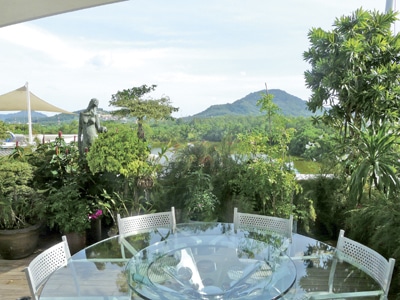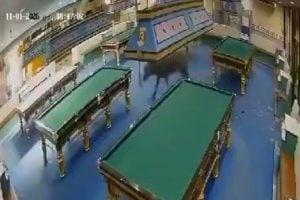Phuket Gardening: Raising the roof

PHUKET: Have you ever felt surplus to requirements? I certainly did on a recent visit to a penthouse roof garden in Royal Phuket Marina. So imaginative in conception and so meticulously tended, there seemed little I could suggest to enhance its lavish charms.
Of course, there are roof gardens and then there are roof gardens.Some are actually constituted of a layer of permeable soil – usually lightweight compost – atop a filter mat of gravel, with a waterproof membrane at the bottom to protect the actual roof. Once established, they can look superb, but they are tricky to maintain, and require a whole system of gutters, downspouts and drains to ensure the “bathtub effect” does not occur.
The other type of roof garden is made up of container plants, arranged as the owner wishes: a semi-moveable feast where shrubs getting too much sun, shade or wind, can be shunted around, both to establish their optimal position and to change the overall visual impact.
Paul Maitland-Smith’s roof terrace was a container-based version, four storeys up, with a swimming pool in the middle, and panoramic views of ultramarine, bays, boats and islands. Not a bad start. But what was equally impressive was the fecundity and variety of the plant life.
One ascended the stairs to burst upon an oasis of vibrant verdancy, flourishing as though impervious to salt-laden winds. Each and every plant was rooted in rectangular custom 316 gauge stainless steel pots – fifty or more of them – and the whole project had been designed with an artist’s eye for different levels and textures.
For example, poles rose from the tiled floor, joined together by wires stretched across the top. But there was no sign of a bare framework: already the trellis-like structures were densely clad in vines, replete with glossy green foliage and small yellow trumpet-shaped flowers.
Probably a variety of odontadenia, these climbers were entwined with passion flowers, and slender coral vines (antigonon) with their racemes of pinkish-red flowers. All vigorous, evergreen climbers, they spanned large areas of the terrace, both aesthetically pleasing and offering some shade and shelter to their smaller brethren beneath.
The whole garden had a sculptural feel to it, in part generated by the owner’s imaginative deployment of plants with unusual shapes and surfaces, for example, yuccas silhouetted against the sky with their spiky crowns, and symmetrical evergreen trees. To give a typically Thai atmosphere, there were “tonsai”trees with variegated leaves, but the accent was on natural shrubs that needed little or no clipping.
Other distinctive, cane-like profiles were provided by stiff reed mace [bull rushes] which were growing right up against the surrounding wall, and several containers of heliconias in full bloom, sensibly positioned out of the full glare of the sun.
One signature shrub, which looked superb with its glossy dark leaves and white pin-wheel flowers, was tabernaemontana, a dwarf variety with a dense, bushy shape, which dramatically complemented the larger shrubs around it.
There were also clumps of costus with their sexy red cone-shaped bracts, and a number of fountain bushes (russelia), so named because of their delicate, broom-like branches, replete with tiny tubular red flowers, arching gracefully over, and softening the outlines of their containers.
A paradise for wildlife? Naturally. At least twenty pairs of birds, mostly spiderhunters and olive-backed and purple-throated sun-birds, happy to feast on the abundant nectar, had built nests in the trees.
Butterflies flitted from shrub to shrub. Oleander hawk moths – in the shape of emerald green caterpillars – had also taken up residence.
As I said at the outset, such a spectacular and well-maintained garden was hardly in need of my advice. Everything, apart from a single sickly purple bignonia, looked in rude health. So, I merely suggested a few additions or alternatives, including some personal favorites. They will put in an appearance in a future article.
Tip of the week – A chip off the old block
WE have all heard the expression, “a chip off the old block”, and we all know what it means – someone who has inherited identifiable traits from a parent.
After all our personal genome pool contains about 15,000 genes inherited from mom, and the same number from dad. So it’s pretty inevitable that we will resemble one or the other of our progenitors in recognizable ways.
With a plant raised from a cutting, the newly created offspring will not just look like its parent plant, it will inherit exactly the same characteristics. One good reason why it is often better to propagate plants thus, rather than trust the unpredictability of seed stock. Of course, it depends on the plant. Annuals, biennials and climbers such as ipomoea are normally renewed from seed, but most shrubs will “take”from cuttings.
There are basic techniques for taking cuttings. Soft stem cuttings are taken from the current season’s fleshy soft growth and are best used for temperate plants such as pelargoniums, or hydrangeas.
Use a sharp knife to cut just below a node (bump in the stem) where the new leaves come from and from whence the new roots will develop in soil.
Semi-ripe cuttings are taken from the new growth just where the soft green stems are ripening and getting a little stronger. These or woody cuttings are best for most tropical shrubs (jasmine, strophanthus, bougainvillea), and climbers such as passion flowers, garlic or coral vines.
For heel cuttings, often the most effective method of propagation, pull the stem from the main plant, but leave a “heel” of tissue. The new plants will form from this.
If you have a question or a garden that you would like featured, you can email the author here.
Keep checking our online Phuket Lifestyle pages or join our Facebook fan page for regular gardening features and tips.
— Patrick Campbell
Latest Thailand News
Follow The Thaiger on Google News:


























